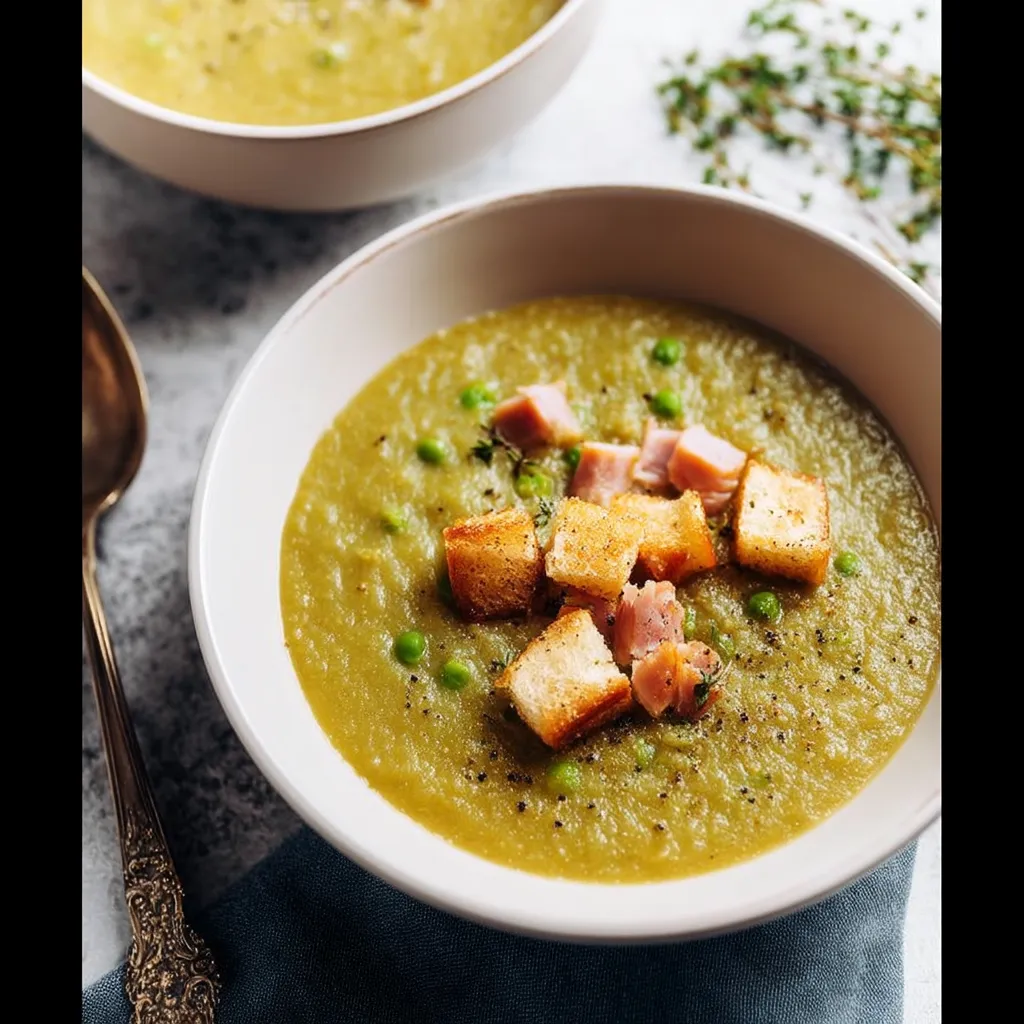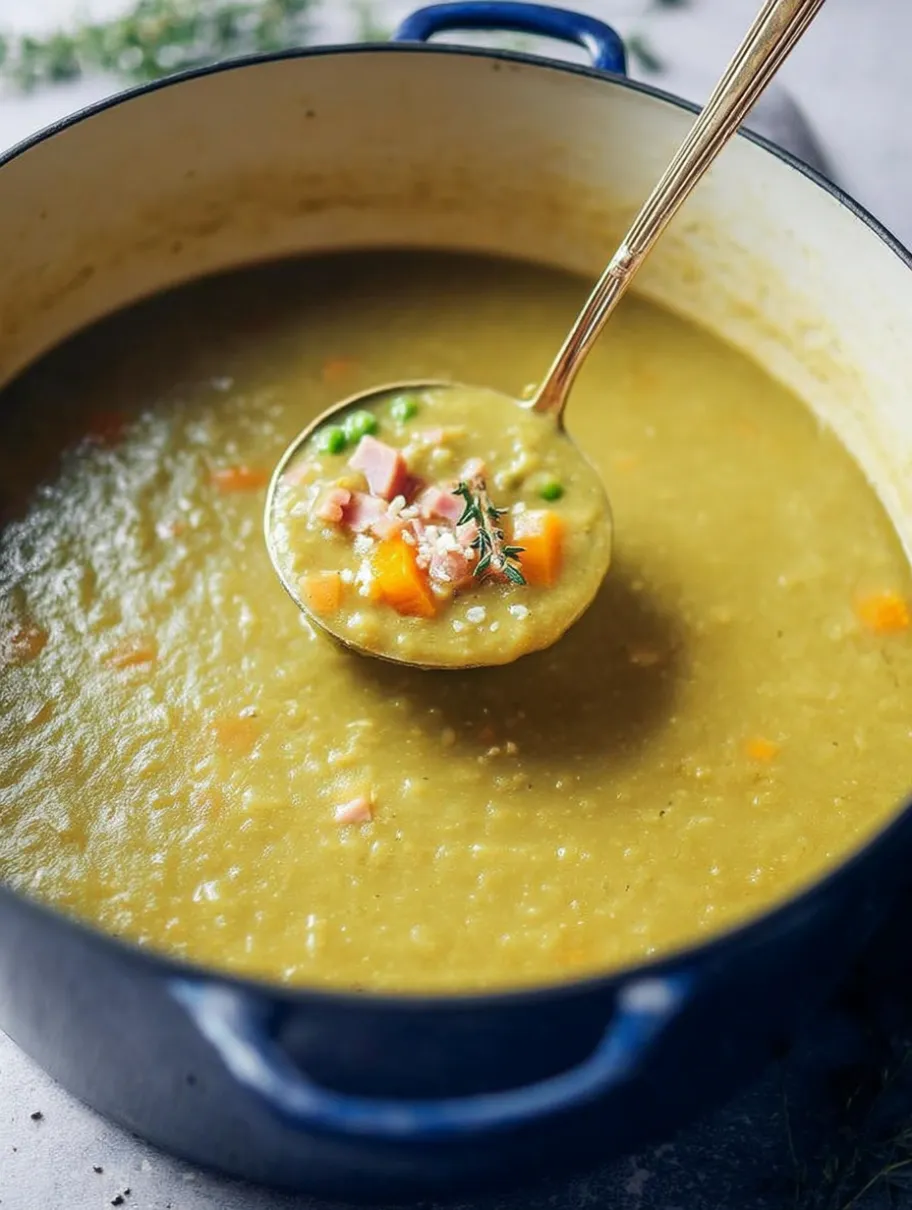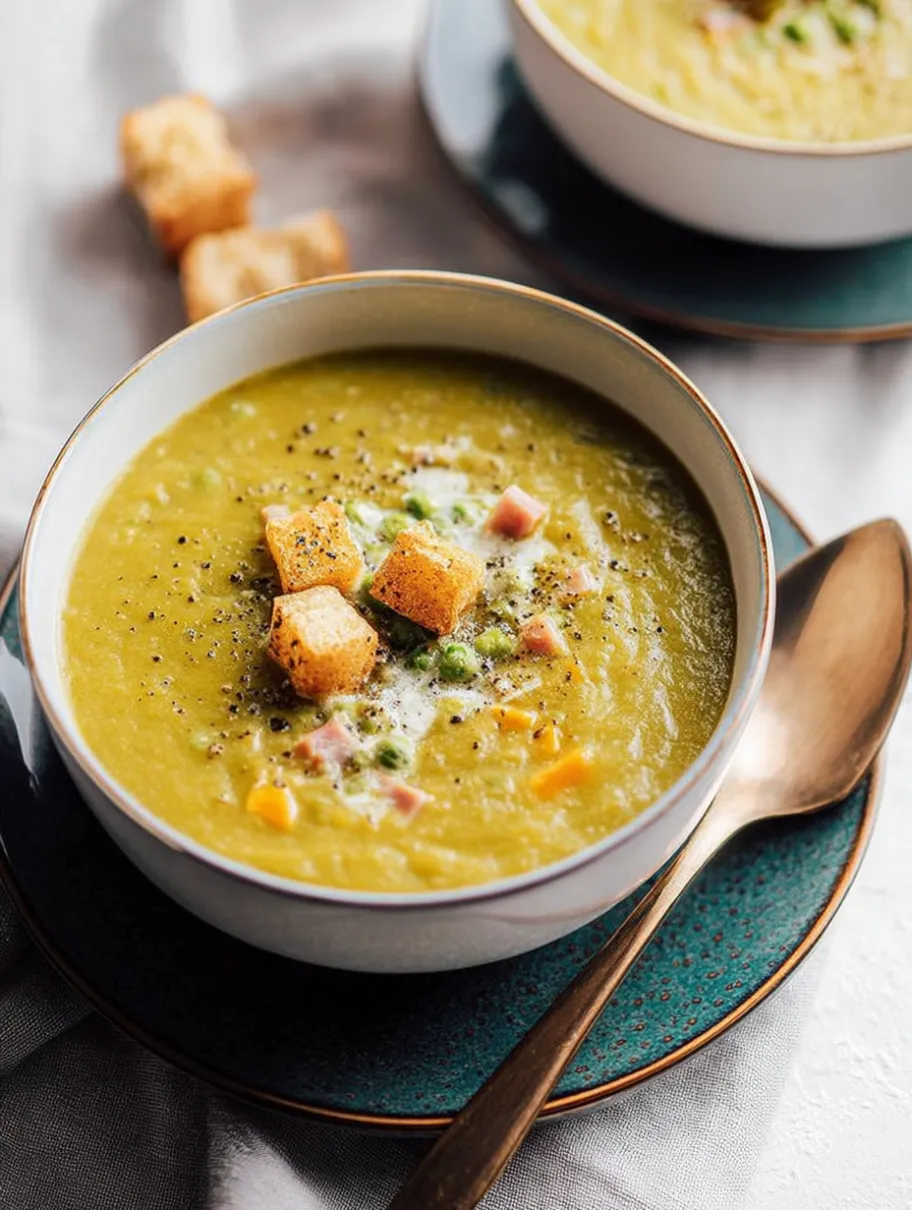 Save
Save
This split pea soup transforms a humble ham bone into a hearty, soul-warming meal that tastes even better the next day. Each spoonful delivers creamy split peas, tender vegetables, and savory bites of ham in a naturally thickened broth that speaks comfort on cold days.
I first made this soup after Easter dinner when I couldn't bear to throw away a beautiful ham bone. My family was skeptical about pea soup until they tasted this version with its rich depth and buttery croutons on top. Now it's requested whenever we have ham.
Ingredients
- Unsalted butter provides a rich foundation for sautéing vegetables while giving you control over the final salt level
- Mirepoix of onions carrots and celery creates the classic flavor base that complements the earthiness of split peas
- Dried split peas require no pre soaking and naturally thicken the soup as they break down
- Meaty ham bone infuses the entire pot with smoky flavor impossible to achieve any other way
- Fresh thyme added in stages preserves its bright herbal notes
- Low sodium chicken stock allows you to control seasoning especially important with salty ham
- Buttery garlic croutons add essential textural contrast to the creamy soup
Step-by-Step Instructions
- Sweat the Vegetables
- Melt butter over medium heat until foaming subsides then add your diced onion carrot celery and initial seasoning. Take your time with this step about 5 to 8 minutes until vegetables soften but don't brown. The vegetables should become translucent and aromatic. This builds your flavor foundation.
- Build the Base
- Add garlic and cook briefly until fragrant about one minute being careful not to burn it. Immediately stir in the rinsed split peas to coat them in the buttery vegetable mixture. This step helps the peas absorb flavor as they cook.
- Simmer to Perfection
- Add your ham bone bay leaf thyme chicken stock and water bringing everything to a gentle boil. Reduce to a simmer and let magic happen for 60 to 90 minutes. The split peas will gradually break down and thicken the soup. Stir occasionally at first then more frequently as it thickens to prevent sticking.
- Finish and Season
- During the final 15 minutes add your diced ham to warm through without overcooking. Remove the ham bone and bay leaf before serving and stir in remaining fresh thyme. This final herb addition brightens the flavor after the long simmer. Taste and adjust salt as needed remembering ham varies greatly in saltiness.

The ham bone is truly the secret ingredient here. My grandmother taught me that a good soup bone should never be wasted and this recipe proves her right. I remember watching her skim the surface occasionally during simmering a practice I continue that ensures a cleaner tasting finished soup.
Adjusting Consistency
Split pea soup thickens significantly as it cools and sits. If you prefer a thinner soup simply add additional stock or water until you reach your desired consistency. For an ultra smooth texture you can use an immersion blender for a few seconds but I prefer leaving some texture in mine. Remember the soup will continue to thicken as it sits so serve it slightly thinner than your ideal consistency.
Ham Options and Substitutions
No leftover ham bone? Smoked ham hocks make an excellent substitute providing similar flavor. They tend to be saltier than a ham bone so adjust your seasoning accordingly. For a meatier version add additional diced ham particularly if your bone doesn't have much meat. For a lighter version you could use smoked turkey instead of ham or even go vegetarian with smoked paprika and vegetable stock though you'll miss some of the traditional flavor.
Serving Suggestions
While delicious on its own this soup elevates when paired with crusty bread or the suggested buttery garlic croutons. A swirl of good quality olive oil or a dollop of sour cream adds richness. In my household we often serve with a simple side salad with vinaigrette for brightness to contrast the hearty soup. Some family members insist on a dash of hot sauce or vinegar to cut through the richness.
Storage and Reheating
This soup naturally thickens as it sits refrigerated making it ideal for meal prep. Store in airtight containers for up to three days in the refrigerator or freeze portions for up to three months. When reheating add a splash of stock to thin to desired consistency and warm gently over medium low heat stirring occasionally to prevent scorching. The flavor actually improves after a day as ingredients meld together.

Recipe FAQs
- → Can I use ham hocks instead of a ham bone?
Yes! Two smoked ham hocks (about 1-1/2 pounds) make an excellent substitute. They tend to be saltier than a ham bone, so reduce the added salt accordingly. After simmering, remove the meat from the hocks, shred it, and return it to the soup before serving.
- → How long does split pea soup keep?
This soup stores beautifully. Keep it tightly covered in the refrigerator for up to 3 days, or freeze it for 2-3 months. When reheating to 160°F, you may need to add a little extra chicken stock to reach your desired consistency.
- → Why is my split pea soup too thick?
Split peas naturally break down during cooking, creating a thick texture. If it becomes too thick for your preference, simply add more chicken stock or water until you reach your desired consistency. Stir more frequently as the soup thickens to prevent sticking.
- → Do I need to soak the split peas before cooking?
No soaking is required! Unlike many dried beans, split peas cook relatively quickly without pre-soaking. Just be sure to rinse them well and sort through them to remove any debris before adding to the pot.
- → How do I adjust the salt level in this soup?
Ham varies significantly in saltiness between brands and preparation methods. Start with minimal added salt and taste the soup after it's finished simmering. You can always add more salt at the end, but you can't take it out. If your ham tastes particularly salty before cooking, consider omitting the initial salt when cooking the vegetables.
- → Can I make this soup vegetarian?
Yes! Omit the ham bone and diced ham, use vegetable stock instead of chicken stock, and add 1-2 teaspoons of smoked paprika to provide that smoky flavor. Consider adding extra herbs or a splash of liquid smoke for depth.
